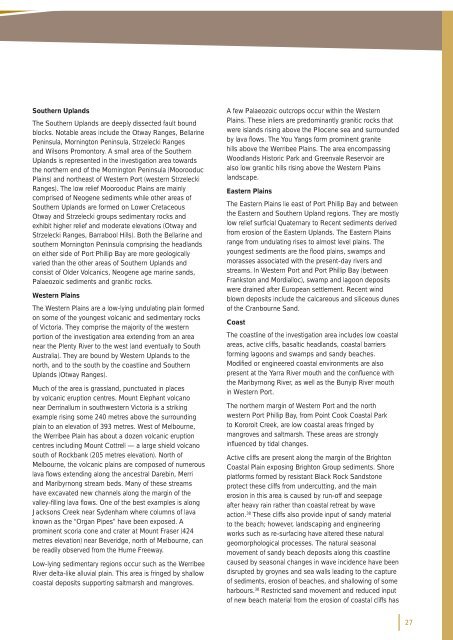Metropolitan Melbourne Investigation Discussion Paper - Victorian ...
Metropolitan Melbourne Investigation Discussion Paper - Victorian ...
Metropolitan Melbourne Investigation Discussion Paper - Victorian ...
Create successful ePaper yourself
Turn your PDF publications into a flip-book with our unique Google optimized e-Paper software.
Southern Uplands<br />
The Southern Uplands are deeply dissected fault bound<br />
blocks. Notable areas include the Otway Ranges, Bellarine<br />
Peninsula, Mornington Peninsula, Strzelecki Ranges<br />
and Wilsons Promontory. A small area of the Southern<br />
Uplands is represented in the investigation area towards<br />
the northern end of the Mornington Peninsula (Moorooduc<br />
Plains) and northeast of Western Port (western Strzelecki<br />
Ranges). The low relief Moorooduc Plains are mainly<br />
comprised of Neogene sediments while other areas of<br />
Southern Uplands are formed on Lower Cretaceous<br />
Otway and Strzelecki groups sedimentary rocks and<br />
exhibit higher relief and moderate elevations (Otway and<br />
Strzelecki Ranges, Barrabool Hills). Both the Bellarine and<br />
southern Mornington Peninsula comprising the headlands<br />
on either side of Port Phillip Bay are more geologically<br />
varied than the other areas of Southern Uplands and<br />
consist of Older Volcanics, Neogene age marine sands,<br />
Palaeozoic sediments and granitic rocks.<br />
Western Plains<br />
The Western Plains are a low-lying undulating plain formed<br />
on some of the youngest volcanic and sedimentary rocks<br />
of Victoria. They comprise the majority of the western<br />
portion of the investigation area extending from an area<br />
near the Plenty River to the west (and eventually to South<br />
Australia). They are bound by Western Uplands to the<br />
north, and to the south by the coastline and Southern<br />
Uplands (Otway Ranges).<br />
Much of the area is grassland, punctuated in places<br />
by volcanic eruption centres. Mount Elephant volcano<br />
near Derrinallum in southwestern Victoria is a striking<br />
example rising some 240 metres above the surrounding<br />
plain to an elevation of 393 metres. West of <strong>Melbourne</strong>,<br />
the Werribee Plain has about a dozen volcanic eruption<br />
centres including Mount Cottrell — a large shield volcano<br />
south of Rockbank (205 metres elevation). North of<br />
<strong>Melbourne</strong>, the volcanic plains are composed of numerous<br />
lava fl ows extending along the ancestral Darebin, Merri<br />
and Maribyrnong stream beds. Many of these streams<br />
have excavated new channels along the margin of the<br />
valley-fi lling lava fl ows. One of the best examples is along<br />
Jacksons Creek near Sydenham where columns of lava<br />
known as the “Organ Pipes” have been exposed. A<br />
prominent scoria cone and crater at Mount Fraser (424<br />
metres elevation) near Beveridge, north of <strong>Melbourne</strong>, can<br />
be readily observed from the Hume Freeway.<br />
Low-lying sedimentary regions occur such as the Werribee<br />
River delta-like alluvial plain. This area is fringed by shallow<br />
coastal deposits supporting saltmarsh and mangroves.<br />
A few Palaeozoic outcrops occur within the Western<br />
Plains. These inliers are predominantly granitic rocks that<br />
were islands rising above the Pliocene sea and surrounded<br />
by lava fl ows. The You Yangs form prominent granite<br />
hills above the Werribee Plains. The area encompassing<br />
Woodlands Historic Park and Greenvale Reservoir are<br />
also low granitic hills rising above the Western Plains<br />
landscape.<br />
Eastern Plains<br />
The Eastern Plains lie east of Port Phillip Bay and between<br />
the Eastern and Southern Upland regions. They are mostly<br />
low relief surfi cial Quaternary to Recent sediments derived<br />
from erosion of the Eastern Uplands. The Eastern Plains<br />
range from undulating rises to almost level plains. The<br />
youngest sediments are the fl ood plains, swamps and<br />
morasses associated with the present-day rivers and<br />
streams. In Western Port and Port Phillip Bay (between<br />
Frankston and Mordialloc), swamp and lagoon deposits<br />
were drained after European settlement. Recent wind<br />
blown deposits include the calcareous and siliceous dunes<br />
of the Cranbourne Sand.<br />
Coast<br />
The coastline of the investigation area includes low coastal<br />
areas, active cliffs, basaltic headlands, coastal barriers<br />
forming lagoons and swamps and sandy beaches.<br />
Modifi ed or engineered coastal environments are also<br />
present at the Yarra River mouth and the confl uence with<br />
the Maribyrnong River, as well as the Bunyip River mouth<br />
in Western Port.<br />
The northern margin of Western Port and the north<br />
western Port Phillip Bay, from Point Cook Coastal Park<br />
to Kororoit Creek, are low coastal areas fringed by<br />
mangroves and saltmarsh. These areas are strongly<br />
infl uenced by tidal changes.<br />
Active cliffs are present along the margin of the Brighton<br />
Coastal Plain exposing Brighton Group sediments. Shore<br />
platforms formed by resistant Black Rock Sandstone<br />
protect these cliffs from undercutting, and the main<br />
erosion in this area is caused by run-off and seepage<br />
after heavy rain rather than coastal retreat by wave<br />
action. 38 These cliffs also provide input of sandy material<br />
to the beach; however, landscaping and engineering<br />
works such as re-surfacing have altered these natural<br />
geomorphological processes. The natural seasonal<br />
movement of sandy beach deposits along this coastline<br />
caused by seasonal changes in wave incidence have been<br />
disrupted by groynes and sea walls leading to the capture<br />
of sediments, erosion of beaches, and shallowing of some<br />
harbours. 38 Restricted sand movement and reduced input<br />
of new beach material from the erosion of coastal cliffs has<br />
27
















